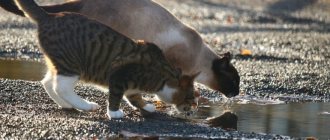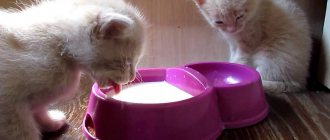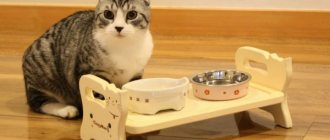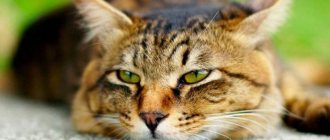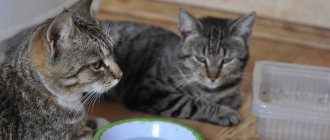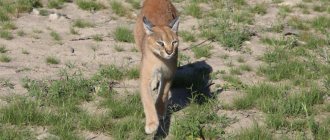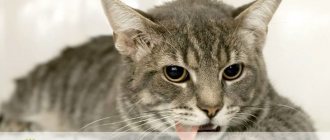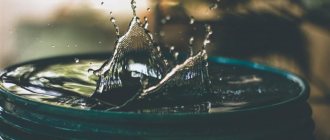Why doesn't my pet drink water?
Every owner, of course, understands the importance of taking care of the proper nutrition and well-being of their pet. Drinking is key to maintaining a healthy body. Interestingly, cats do not drink water as often as people. But it is still necessary to restore the water balance. Before teaching cats to drink water, we recommend that you read the advice of experienced cat owners.
To start, choose a good bowl. The fact is that dishes of small volume or made of low-quality material can scare the animal away from drinking. In the first case, the pet's whiskers (vibrissae) may interfere. The second is the odor or toxicity of the material. For example, utensils made of plastic may give off a taste or odor. As you know, cats have a very good sense of smell. Therefore, if you are inclined to believe that the cat does not like to drink water for this very reason, quickly replace the dishes with new ones. Alternatively, you can choose a glass, aluminum or ceramic wide bowl.
Another option why cats don’t drink water from a bowl is its location next to food. Yes, in nature everything is arranged in such a way that animals do not drink where they eat. Some explain this by saying that a plate with liquid placed next to a food bowl will be perceived as food. In addition, for the animal it may not seem completely clean due to its close location to the dishes for the “main dishes”. In this case, we recommend that you place the bowl of water in a different place. To begin with, you can choose several locations and place dishes for liquid throughout the apartment. One bowl, for example, can be placed in the living room, another in the bedroom, and a third on the balcony. As soon as you notice that your pet has taken a fancy to one of them, the rest can be removed. It is important that the drinking container is not placed in a passage or draft area.
The next reason why a cat does not drink water from a bowl is that it may not be washed well. While humans feel it weakly, cats have a keen sense of smell. Regarding taste, everything is a little different. But if there are remnants of detergent or not entirely fresh water in the bowl, your pet will feel it. For prevention purposes, the water should be changed at least once a day. And it is also important to know this information. In nature, cats prefer to drink water from flowing streams.
How much should a cat drink?
If a cat drinks water very rarely, this does not mean that she drinks little. It is important to be able to determine the amount of water you drink. Finding out how much water a cat drinks is not difficult. For this purpose, several vessels with a measured amount of water are placed around the home. Over the course of several days, the amount of remaining liquid is measured.
A healthy animal weighing 3 kg should drink an average of 100 ml of water per day. Fluctuations can be up or down depending on the time of year, temperature and humidity in the apartment. It is impossible to control cats that constantly walk outside, compared to a domestic pet that does not know what is beyond the threshold of the apartment.
How to teach a cat to drink water from a bowl
Probably, many owners can complain about this problem. In nature, a cat is also accustomed to the fact that it receives liquid while hunting for rodents. If the pet is at home, then it eats completely different food. A cat's diet may include porridge and boiled minced meat. If your pet eats dry food, which can also be an acceptable solution if you do not have the opportunity to constantly cook, you need to take care of the animal’s drinking.
To train your cat to drink water:
- Choose convenient utensils. We talked about this in more detail earlier, looking at why a cat doesn’t drink water from a bowl;
- Change the liquid in the dishes daily;
- Mix water with dry food, add it to cat dishes, milk, and so on;
- Buy ready-made canned foods that contain water;
- If the cat does not have throat problems, you can put an ice cube in the bowl. The cat will lick it and get moisture this way;
- The instincts of animals determine their behavior in such a way as to drink running water. If your cat doesn't drink enough fluids, try introducing him to tap water. To do this, turn on the water slightly and help the cat sit down so that it is comfortable;
- Also for this reason, we recommend taking a closer look at a very interesting device - a fountain with circular water circulation. In some devices it is filtered. There are also models that turn on when the cat approaches;
- If the cat does not drink plain water, mix it with fish broth.
In any case, you need to accustom your cat to water. Proper drinking keeps the body functioning. If the cat’s diet contains a lot of dry foods, liquid is an essential component. When training, keep in mind important rules, as well as the need to select the correct container.
Sphinx food.
A cat needs a lot of protein.
In cats, the intestines are structured differently and some “human” food remains simply rot inside, which is the cause of many diseases. Ideally, the ratio of protein to carbohydrates should be 2:1. And it should also be taken into account that pebbles require more calories, because... they warm themselves. products containing protein in descending order: beef; dairy products; wheat; egg; chicken; lamb; soy; corn; pork (although any veterinarian will tell you that no animal should eat pork); rice; fish.
Feeding a small Sphynx: they begin to give water constantly from 2.5-3 months (younger kittens usually do not drink water). Milk is food and should not be used instead of water. A one-month-old kitten is given approximately one tablespoon of food per feeding. The frequency of meals for a one-month-old kitten is 4-5 times and by 6 months it is reduced to 1-2 (in practice this is not realistic. Ours is already a year and a half old and he eats at least 3-4 times a day, but in small quantities). Any Sphynx (I would say any domestic animal) has a good appetite and is easy to overfeed, especially at a young age. he will become obese and it doesn’t look as charming as those of his furry brothers, believe me, I saw one of these at an exhibition. So, don’t spoil him with sweets and fatty foods, especially since this is harmful to the liver - it is very vulnerable in all cats , as well as the urogenital system.
Here is an approximate diet for sphinxes: 1) meat (raw beef), boiled chicken (except skins), raw or boiled beef liver - 60% of the total diet.
2) dry food – 20% of the total volume.
3) dairy products (ryazhenka, baked milk, cottage cheese, milk oatmeal and semolina porridge) - approx. 15% of r.p.
4) porridge with water (oatmeal, semolina rice) and vegetable soups (carrots, cabbage, finely grated zucchini + oatmeal) – approx. 5%
5) boiled egg or raw egg yolk – once a week.
6) treats – approx. 1%
Like that. At first, when I was a kitten, I cooked everything as it should, but as I got older, I stopped. I just make sure that I don’t overeat and that the food isn’t too fatty.
Source
Water requirements
Now let’s summarize the above and supplement the information with some interesting points. Of course, there are certain requirements for water. Although some cats still surprise us by the fact that they can drink dirty water on the street, or even climb into the toilet. If you notice similar behavior in an animal, try to be patient to retrain it. In fact, water is very important for the health of an animal's body. Of course, sometimes it’s very difficult to teach an animal to drink. If you still can't get your cat used to water, try our other tips. We reviewed them above.
We also recommend that you consider the following points:
- Temperature of the liquid in the bowl. In nature, wild cats are accustomed to drinking water from streams or other sources. Of course, such predators are more adapted to survival conditions. At home you should give water at room temperature. It is important to know that sometimes animals can have throat problems;
- Purity. Tap water may not always be suitable. Moreover, in different regions its quality may vary significantly. Even a person can feel chlorine impurities. And what can we say then about pesticides, metals and sedimentary material? Of course, drinking water from the tap can help build immunity. But also take into account how clean the water is in your area and whether it is suitable for drinking;
- Foreign odors. A cat will not drink water from a bowl if it contains aromas that are unpleasant to its receptors. For example, chemicals or the smell of the bowl itself, well-washed food debris or stagnant water. Therefore, pay attention to cleanliness and the washing process;
- How often to change. Make sure that the water does not stagnate for a long time and is not dirty during the day. Change it once a day, sometimes more often.
What are the consequences of lack of fluid?
If an adult cat or small kitten does not eat or drink, the pet can become seriously ill, since dehydration can lead to the following ailments:
Against the background of this condition, blood clots may form in the animal as the blood becomes thicker.
- Urolithiasis disease. Cats have concentrated urine, so if the cat begins to refuse fluid, this leads to the formation of struvite. If stones block the ureters, urine is not excreted from the body. This is dangerous due to uremia and general intoxication, which is dangerously fatal.
- Blood thickening. When a pet doesn't like to drink, it leads to viscosity and poor circulation. The condition increases the load on the heart, reduces the functionality of the liver and kidneys, provokes oxygen starvation of tissues, the formation of blood clots, which ends in death.
- Kidney failure. It occurs in acute and chronic forms. It is characterized by suppression of kidney function, accumulation of harmful substances in the body, and increased blood pressure. The most susceptible to pathology are British, Maine Coon, and Persian cats.
- Dehydration. This is a critical lack of water in the animal’s body, in which all organs and systems suffer. If a pet does not drink for more than 2-3 days, there is a high probability of irreversible changes and death.
Interesting Facts
The origin of the cat is associated with its African history. It was in Egypt that these animals were revered most of all, they were looked after, kept clean, tidy, and extolled. A weakened craving for water and a feeling of thirst are associated with the remaining need for a small amount of water on a dry continent. But we know how important it is for a cat to drink. Therefore, you need to replace your water balance through drinking or eating.
Every owner wants their cat to be healthy. Satisfying the daily need for water (1.5-2 times more than food intake, especially if it is dry food) helps normalize metabolic processes, prevent stagnation and possible infections of the genitourinary system. Cats love to drink water from fountains, so if your pet actively asks for water from the tap, you can buy such a device for him.
Sometimes cats drink liquids from non-standard containers, such as a bucket, sink or mug. If you have the opportunity to give your pet such a drinking item, fill it with more water and place it in an accessible place. In summer, you can take a wide bowl and leave it on the balcony.
A cat's daily water requirement
If we talk about the daily water requirement of cats, it is approximately 60 ml. per 1 kg. animal body weight . In terms of the amount of dry matter consumed, this requirement is 2 ml. for 1 g of such substance.
This amount of water should not be considered as the amount that a cat must drink per day, since other factors should be taken into account: dry or wet food the animal consumes, whether it drinks milk or other liquid, whether it is cold or hot in the room where the pet lives, age and the breed also play a role, as well as the energy expended, in other words, the activity of the cat.
Furry friends should have constant access to water, which should be clean, free of impurities and foreign odors.
You shouldn't overuse distilled water either; long-term use can harm your cat's teeth. The water container should also be clean; glass or ceramic containers are preferred over plastic ones.
